
MAY CONTAIN NUTS

Search Shorpy
SHORPY ART

Framed or unframed, desk size to sofa size, printed by us in Arizona and Alabama since 2007. Explore now.
Join and Share
Ad-Free Shorpy
Shorpy is funded by you. Patreon contributors get an ad-free experience.
Learn more.

Recent comments
- Baldwin 62303
- Baldwin VO-1000
- Cold
- No expense spared
- Tough Guys
- Lost in Toyland
- And without gloves
- If I were a blindfolded time traveler
- Smoke Consumer Also Cooks
- Oh that stove!
- Possibly still there?
- What?!?
- $100 Reward
- Freeze Frame
- Texas Flyer wanted
- Just a Year Too Soon
- WWII -- Replacing men with women at the railroad crossing.
- Yes, Icing
- You kids drive me nuts!
- NOT An Easy Job
- I wonder
- Just add window boxes
- Icing Platform?
- Indiana Harbor Belt abides
- Freezing haze
- Corrections (for those who care)
- C&NW at Nelson
- Fallen Flags
- A dangerous job made worse
- Water Stop
Member Photos
The Shorpy
Print Emporium
Print Emporium
Search Shorpy
Search results -- 30 results per page
- Princess Unplugged: 1950
- New Zealand circa 1950s. "Model with wringer washing machine." I am Woman, see me ... point too subtle (for me) at that time of the morning.
New Zealand Laundry New Zealanders must be quite eccentric to be able to ... Posted by Dave - 04/10/2014 - 5:00pm -
![Princess Unplugged: 1950 New Zealand circa 1950s. "Model with wringer washing machine." I am Woman, see me Wash. Photo by Gordon Burt Studio. View full size.
Something missing.There is no plug on the washing machine. Kind of hard to wash clothes without one.
Something vital is missingShe will be able to get a lot more done if the washer was connected. Why no plug, and just an unterminated cord?
Perhaps it is the precursor to inductive charging.
Lucky GirlMen in the Western civilization have always spoiled our women by allowing them to have electric appliances, educating them, and allowing them to carry their own money.
Me being picky I'm sure she'll get better performance out of the machine, when there's a plug on the end of the cord - and it's plugged into a socket.
[I guess no one noticed the title of this post. - Dave]
Yep, a point too subtle (for me) at that time of the morning.
New Zealand LaundryNew Zealanders must be quite eccentric to be able to wash clothes in an unplugged washing machine. Either that or they are much smarter than the rest of us to have figured out how to get the machine to work without plugging it in.
Princess IndeedIt blows my mind to think of doing laundry (even with today's machines!) in a dress, stockings and heels. Oh and with my hair curled.
[Princess is, for those who have not zoomed in, the brand of the machine. - Dave]
A Bit Ahead of its TimeMust have been invented before wall outlets and plugs on cords. But at least it's not gasoline-powered like the one my grandmother had. As a kid of six, I spent a summer with her and laundry day was a noisy outdoor affair with the old one-banger. Primitive as it was, it was the once convenience Grandma had. The whites got boiled over a wood fire in an old cauldron with "bluing". This young woman looks like a twin for my niece, but thankfully my niece got a new washer and dryer just yesterday.
Somebody cut the plug offWhy?
One of the wheels is bentPoor machine must have had a hard life.
That's settledNow that the plug explanation has been crowd-sourced, what color would that magnificent contraption be? It predates the fad for avocado or harvest gold appliances, but even in grey scale, it's pretty clear that the tub is not "refrigerator white."
Three wireObviously she won't get much washing done with the cord hanging loose like that, but I see that at least she will be protected from electrocution once they get the thing properly wired up.
That washer won't wash.Is there some sort of world wide conspiracy to sell washers without a $#@% electrical plug attached to the power cable?
Pretty model.
This will work much betterIf you have the power cord end attached.
Plug: optionalMost likely, this appliance was sold in several countries, necessitating plug installation at points of delivery to be compatible with the outlets used in that locale.
Danger: Electrocution hazard!Unplugged?!? There's not even a plug on the end of the cord. Her hairstyle could undergo a radical transformation when she pushes those wires into the wall socket.
Kiwi KitchenThe high end kitchen appliance manufacturers Fisher and Paykel is a New Zealand based company. They developed the "kitchen drawer" dishwasher.
TeslaIt worked on the Tesla principle he invented where electricity was broadcast through the air.
Safety firstNo plug on the cord insured that the that pretty lady didn't get any part of her pretty self caught in the wringer.
No plug ?In some countries,like the UK, there was no one standard electrical outlet as in North America. Appliances were supplied with no plug, so that the user could supply the one that fit their particular outlets.
Customer SuppliedVarious options exist for the connection of electrical equipment, especially in earlier days or across different regions. Existing outlets of different ratings will have different plug configurations. Direct hard wiring of larger appliances is sometimes used with a disconnect switch that is surface mounted on the wall. The customer or installer would buy and attach the appropriate cord cap to match a particular location or existing outlets.
Brings Back MemoriesI remember clearly at the tender age of 4 helping my grandmother with the laundry and getting my arm caught in the wringer. Fortunately, she wasn't too far away and released it before any damage was done. But even to this day my right arm seems a bit flat.
Standards are great, there are so many to choose fromIt's just barely possible that sockets and plugs weren't as standardized in 1950s New Zealand as they are today. It may have made sense to ship appliances with no plug, and let the dealer or customer install the right plug to match the customer's house.
An example from another country: The UK officially switched to their current plugs and sockets right after WWII, but the previous standards remained in use. For a while it was *illegal* to sell an appliance wthere ith a plug on the cord - the theory was that if somebody bought an appliance with the wrong plug for their socket, they would just chop the plug off, leaving a plug with a bit of wire sticking out the end. A small child would then find this plug+wire, somehow find a matching socket, plug in the plug+wire, and zap themselves. In theory, anyway. Part of the regular school curriculum was "how to wire a plug".
Plugs might not have been standardizedI seem to recall on an electrician's forum several years ago, that one Australian had dug up some documents showing that their standard plug only dated to 1938 (and it is well-documented to be originally an American design). Australia and New Zealand now share the same electrical standards, but I don't know if this was true in the '50s. Even today, I think many appliances in the UK require the user to install their own plug (witness the Tenth Doctor Who describing Donna Noble as someone who "can't even change a plug").
A benefit of waiting so late is that the need for grounding appliances was already evident. I have a 1930 American book warning of the special hazard of not grounding washing machines, and recommending using a plug that matches today's Australia/New Zealand plug. This advice was not officially sanctioned until 1947, and went mostly unheeded until 1962.
Mom's warningI can still remember my mother telling me in no uncertain terms not to put my fingers anywhere near the wringer and that was probably 62 years ago.
Plugless PrincessLack of standardization of international electrical socket configurations and standards at the time led some manufacturers to ship their machines without plugs. It was the responsibility of the local installing dealer to provide a compatible one, be it with round pins, parallel or non-parallel flat blades, polarized or whatever. Also, jumpers in a junction box inside the machine often had to be changed to match local line voltages or 120 or 220 and frequencies of 25, 50 or 60 Hz. Not having a plug on the machine was an attempt to insure it would get properly setup by someone who knew what they were doing (although it didn't stop resourceful 10 year old boys from taking a lot of things for pre-installotion test drives).
Why botherWe owned one of these dang things when I was a kid, my mom didn't need a plug on hers either because it was easier to go to the laundromat!
Colour of the tubI remember seeing machines like this in the second-hand shops and the colour always seemed to be middle-of-the-range green. Not dark green or pale green but somewhere in the middle.
(The Gallery, Kitchens etc., New Zealand)](https://www.shorpy.com/files/images/SHORPY_FL16822836.thumbnail.jpg)
- Fleetwood: 1960
- ... television circa 1960." Studio of Gordon Burt, Wellington, New Zealand. We don't guess this would stream Amazon or Netflix. View full size. ... Posted by Dave - 09/09/2013 - 9:05pm -
![Fleetwood: 1960 "Fleetwood television circa 1960." Studio of Gordon Burt, Wellington, New Zealand. We don't guess this would stream Amazon or Netflix. View full size.
Stylin' in the Southern HemisphereThose itty-bitty mid-century modern legs are a hoot!
FIVE buttonsTechnology marches on.
TV in New ZealandTelevision reached New Zealand in 1960, later than many parts of the world. It was an expensive medium for a small country, and our uneven terrain made it difficult to get a clear signal to some areas.The hours of transmission were from memory 6pm - 10pm, and only available in black & white until 1974. Our family got its first TV in 1964, and was similar to the one in this image. Great memories
Not even UHF!Streaming? It doesn't even have a VCR input. Anyone know what the buttons did - select stations? But no, it has a tuning knob.
Looks like a rebadged RCA TV to me... Can't find a picture online at the moment - maybe if I bang it on the side it will pick it up!
Brings back memoriesMemories of getting in trouble, that is! When I was about 4 years old, circa 1967, we had a TV with the cloth speaker cover, and I took a ball point pen and drew all over it.
DarnI was expecting a Caddy.
On a rollTwo of the buttons are "horizontal" and "vertical" roll control and as sets aged they got increasingly more sensitive to control and you had to constantly adjust the knobs, especially in remote areas. Being an old TV repairman from the '70's this was one of the more aggravating problems with tube type sets, and a lot of my older customers held on to sets from the 60's and even late 50's. Solid state cured that as well as my occupation.
Still work?If I had one of these old television receivers in working condition now would it still receive over the air transmissions, albeit without color?
[New Zealand's conversion from analogue to digital television broadcasting is scheduled to be complete by the end of this year. Older sets require a converter. -tterrace]
TV TechOur first set was a 1953 Dumont table model. Although we were in rural Kansas, it sounds a lot like New Zealand 10 years later. We had only one channel (CBS) for about the first year we had the thing; it took 2-3 years to get all three networks, with the help of rabbit ears. The set had a flip-open control panel where things like the vertical and horizontal hold controls were. There were some even more obscure controls on the back; we never messed with them, out of fear that it would screw up the marginal reception even more. My first political memories were of the 1956 conventions. Although we were a Republican family, I was mad at the GOP because its convention preempted the Mickey Mouse Club most of the week, whereas the Democrats' did not.
So many buttons@loujudson. Didn't see your comment before. There are actually eight knob controls; an inner and outer. vertical and horizontal on the bottom, next up is brightness and contrast (pretty self explanatory) and then volume and tone control. The outer ring on the channel changer is for fine tuning. Now I can't quite make out what the push buttons are labeled, maybe something just for New Zealand?
p.s. Dave, could we get an enlargement of them?
[OK, but don't touch them. -tterrace]
TV in AustraliaAs he was a single man (with not much to spend his money on in those days)Dad bought a TV when they first came out in Melbourne, Victoria - in 1956, for the Olympic Games.
Not all states got TV in 1956 - I know Perth was much later.
He got married a few years later, and I still remember the telly, which looked quite a bit like the one above. I also remember hiding behind the sofa while attempting to watch Dr Who.
We got a colour TV in the mid Seventies, about a year after colour was first broadcast. Australia chose the PAL system, which gives a much better image than NTSC.
In 1956 my dad was still working as a commercial photographer, probably for the infamous Athol Shmith - I do wonder if one day I'll see something of his on Shorpy!
(Technology, The Gallery, New Zealand, TV)](https://www.shorpy.com/files/images/SHORPY_FL16661744.thumbnail.jpg)
- Just Add Water: 1959
- August 27, 1959. Wellington, New Zealand. "Swimsuit fashion show at James Smiths Ltd." Another picturesque scene ... those mannequins looked back then. But considering New Zealand's place on the globe, aren't these figures almost standing upside ... Posted by Dave - 08/15/2013 - 12:38pm -
![Just Add Water: 1959 August 27, 1959. Wellington, New Zealand. "Swimsuit fashion show at James Smiths Ltd." Another picturesque scene from the mysterious parallel universe of the Southern Anglosphere. Evening Post photo. View full size.
Remarkably LifelikeIt's amazing how realistic those mannequins looked back then. But considering New Zealand's place on the globe, aren't these figures almost standing upside down??
Two pointing fingers?The little girl on the far left has her index finger pointing toward the floor and the blonde sitting on the right? Her index is just out there also , yet she is looking at the girl. Interesting.. maybe it's a unified way to say "we're number one"?
Is It Cold Out?OK - its late August but the lady on the right behind the mike is wearing a heavy coat, hat, and scarf. Is is safe to assume this is one of those "end of season sales", and only the models (or perhaps customers) are trying on the goods. The lady on the left with her back to the camera also appears not to be in summer clothing. Wonder what the temperature was outside that day?
[Seeing as how it's winter, it probably is cold out. -tterrace]
Seasons reversedDown Under, August is the equivalent of a northerly February, with days and nights in the 50's and 40's Farenheit. These cuties are getting ready for the hot weather ahead in December and January!
Winter in New ZealandWe are in winter at this time. I live 90 mins drive from where the photo was taken. James Smith Ltd is a department store and commonly known as 'James Smith Corner'. Great to see these photos of my country on Shorpy.
(New Zealand, Pretty Girls, Stores & Markets, Swimming)](https://www.shorpy.com/files/images/SHORPY_FL12969781.thumbnail.jpg)
- On the Ground: 1905
- New Zealand circa 1905. "Unidentified group having a picnic outside tent in backyard of house, probably Christchurch district." Are New Zealanders the most picnicking people on the planet? Glass negative by Adam ... Posted by Dave - 11/23/2013 - 12:44pm -
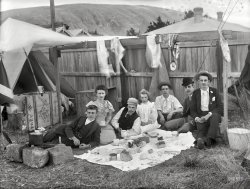
- Gearheads: 1916
- ... Sept. 26, 1916. "Boys of Wanganui Technical College, New Zealand, during an engineering class." Tesla Studios glass negative. View ... Posted by Dave - 05/27/2014 - 11:35am -
![Gearheads: 1916 Sept. 26, 1916. "Boys of Wanganui Technical College, New Zealand, during an engineering class." Tesla Studios glass negative. View full size.
An OSHA NightmareBut I would have loved a class like that!
No OSHA equivalent in 1916 New ZealandThey sure as heck wouldn't have let us work with spinning machines, while wearing ties that could have gotten caught in them, in my shop class. And not one protective eye goggle anywhere.
TiesMy first thought was "surely Shorpy comments won't state the obvious concerning ties and machinery."
[Let's not forget OSHA. - Dave]
Hello OSHA, here's what happenedA room of moving and spinning equipment and all those neckties.
RubberneckersEgads! I wonder how many boys were injured before they discovered that ties and moving machinery don't mix?
The machinery (and ties a bit)That is a pretty complete set of machine tools in there, I am particularly impressed by the set of gears that go with the metal lathe near the center. The boy in the front is holding a mill file, probably they taught proper draw-filing technique for creating flat and true surfaces.
The ties no doubt indicate their class standing and, since this is a posed picture, are probably tucked into their shirts when actually working with the equipment.
At First GlanceI thought I was seeing a Lewis Hine scene of downtrodden young boys, but as soon as I saw the neckwear I knew it wasn't going to be that bad.
Damn the hazards!When our shift ends, we're off to camp!
Changing timesThere is so much to look at here, besides the frightening neckties. The pyramidal change gear stands are neat for sure. Also notice the two marine engines in the right foreground. The taller single cylinder engine on the metal stand is one of those new-fangled internal combustion models, but just behind and to the right you see a classic double expansion steam launch engine perched on a crate.
It's a digital worldTime for the photograph, boys. Everyone with ten fingers, move to the front.
Too young?Aren't some of these kids too young to be in a Technical College or is this just a substitute for a trade high school?
I had a class like that.I went to Stuyvesant High School in New York and we had a wood shop with all the overhead belts and pulleys. They powered lathes, joiners, planers, grinders, etc. I can still hear the noise of the electric motor that drove them and I can still smell the wood. We did NOT wear ties.
Not mentioning tiesAre they making appliances?
Hooks! We need hooks!Where are we to hang our coats?
Beneath it all...Is a wood-block floor.
I never understood why they were used; perhaps in a 'light' industrial environment they were more economical and durable than concrete (or iron-infused concrete).
The Wood Bock FloorsI have no idea if they are still used but when I retired in 1994 the large company I worked for who has many factories around Illinois used those creosote soaked wooden blocks over concrete.
Crews were constantly replacing bad blocks. From what I remember they absorbed falling metal parts so they weren't damaged and were easier on a person standing eight hours a day. I'm sure often moving machinery to new locations also had something to do with it.
I didn't have a job where I had to stand nearly that long. But personally my legs and feet ached from those blocks.
(Technology, The Gallery, Education, Schools, New Zealand)](https://www.shorpy.com/files/images/SHORPY-FL16675535.thumbnail.jpg)
- Wabbit Season: 1910
- ... View full size.
A plague of rabbits @solo: New Zealand definitely has problems with overpopulations of introduced rabbits, to ... Posted by Dave - 09/13/2013 - 8:56pm -
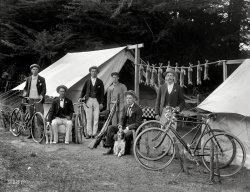
- Rotorua Cadillac: 1938
- New Zealand circa 1938. "Cadillac 353 V8 service car operated by Rotorua Motors." ... Wagon", no, the term "service car" is perhaps unique to New Zealand , where it meant a long haul passenger vehicle that was operated ... Posted by Dave - 01/03/2014 - 9:59am -
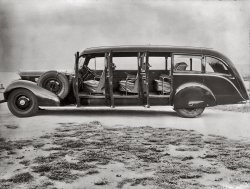
- Look at the Time: 1950
- Wellington, New Zealand, circa 1950. "Household appliances including washing & sewing ... like it could be the current (ha) standard Australia/New Zealand plug , but it could also be a US-standard plug with U-shaped ... Posted by Dave - 04/26/2014 - 5:19pm -
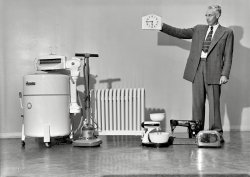
- Rambler Biclorama: 1902
- Auckland, New Zealand, 1902. "Dexter & Crozier, cycle importers, Victoria Street East." ...
Dexter & Crozier From The Cyclopedia of New Zealand :
The business premises contain a large show-room, with ... Posted by Dave - 08/13/2013 - 3:31pm -
![Rambler Biclorama: 1902 Auckland, New Zealand, 1902. "Dexter & Crozier, cycle importers, Victoria Street East." Glass negative by James Hutchings Kinnear. View full size.
Dexter & CrozierFrom The Cyclopedia of New Zealand:
The business premises contain a large show-room, with offices at the front, and behind there is a large repairing shop, with lathes, a forge, and brazing and enamelling plant.
Demolished?There appears to be nothing left of the buildings shown. I went to Victoria Street East yesterday and carefully looked for remnants, but saw none. I suspect the cycle shop and the buildings on each side were demolished long ago, the site now being occupied by the Lister Building.
SignedThe signpainters: Bollard & Froude.
[Also Tudehope & Robertson. - Dave]
A touch of homeA sad looking houseplant on a windowsill of the Board & Residence hotel.
Rambler rumbleBicycling dandies versus piano-playing toughs. Play it cool boy, real cool.
Backseat driverTwo tandems and the one on the right seems to have an arrangement that allows it to be steered from the rear seat.
Rambler bikes and cars These Rambler bikes came from the Gormully and Jeffery Mfg. Co. of Chicago. By the time the instant image was snapped, Thomas Jeffery was in his 5th year of producing automobiles. In 1901 he introduced the Model A Rambler, a name that would much later be tied to Nash products. The G and J (Gormully and Jeffery) Tire Co. sponsored two races at the Indianapolis Speedway prior to the first 500 in 1911.
... on a bicycle built for two, or maybe three?interesting, the first bike has the more modern low set handlebars one associates with racing bikes. I can't help but feel sorry for the person sitting in the second seat if the first has some digestive problems.
The second bike however has the step-through frame more commonly associated with ladies' bikes in the first position, with the step-over bar for a gentleman in the second position. Both are equipped with the "sit up and beg" style handlebars. I'm trying to decide if there is a saddle or at least a seatpad on the crossbar in the second position - perhaps for a child?
The Coffee RoomYeah right, like anyone will ever make money just selling cups of Coffee.
The Tandem on the RightThe tandem on the right appears to be steerable from the stoker position, but I'm having trouble understanding the geometry. I've never seen such a configuration. Can anyone help a brother out with an explanation?
Courting Tandem!The tandem to the right has a curious frame: a few more tubes than usual; step-through frame in front; parts going from the fork to the rear rider! An initial google search for 'tandem stoker steering' yielded the term 'courting tandem'. Search that for description, photos and antique bikes for sale. Is that a leather chainguard at the front chainwheel?
Chainwheel of the left, uphill tandem is interesting: a very large tooth pitch. Chain looks pretty normal, though. One tooth per three links?
A franchise?At about this time there was apparently another "Biclorama" located in San Francisco. It was billed as "Thos. H.B. Varney's Rambler Biclorama: The Largest and Most Complete Bicycle Establishment in the World." Specifics are scarce, but some material is available from Google in printed form only.
Never locate a bicycle shop on a hill. The considerable extra energy required to pedal up hill can be too much of a reality check for a newbie cyclist.
Blind BustThe head to the left of the piano sign is very interesting with the eyes covered with a wrapping, odd indeed.
HillyBill T. said: "Never locate a bicycle shop on a hill."
You don't know Auckland! It's hilly almost everywhere in the CBD, except for Fort Street, Customs Street, and Quay Street, which are all built on land reclaimed from the harbour.
Opposite ends of the tandem spectrumThese bikes represent the two extremes of turn-of-the century tandems. The bike on the right would have been most at home pootling down a garden path, while the one on the left was built for the velodrome.
fastRfastR is quite right that the bike on the right with the leather chainguard is a rear-steered courting tandem. This was probably the most common tandem configuration in the 1890s.
While the bike on the right is built for leisure, the one on the left is a speed machine that concedes little to comfort, especially for the stoker. While tandems were raced on the track in their own right, they were more often used as pace bikes. In certain types of trials, tandems, triplets and even quads and quints "towed" bikes up to speed in their slipstream before the final laps.
The "skip-link" chainring on the track bike was not uncommon on racing bikes into the 1940s. Alternating short and long links allows the use of stronger, higher profile teeth on the chainring than is possible with a standard chain, which in turns means fewer broken teeth for both bike and rider.
Rambler logosIt's interesting to see how many ways the Rambler logo is interpreted in that single scene. Brand identities were much more flexible back then. I spotted yet another Rambler logo in a Stockholm bike shop a few years ago.
(The Gallery, Bicycles, New Zealand)](https://www.shorpy.com/files/images/SHORPY_FL16733413.thumbnail.jpg)
- Haka Twerk: 1913
- ... war cry, dance or challenge from the Māori people of New Zealand.
New Zealand, 1913. "Maori boy performing a haka on the beach, ... Posted by Dave - 10/06/2013 - 12:25pm -
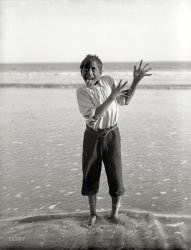
- Dream Kitchen: 1930s
- New Zealand circa 1930s. "Model at sink in kitchen equipped with Atlas electric ... old stove!
Energy management I can't speak to 1930s New Zealand specifically, but in many countries, it is common practice to have ... Posted by Dave - 08/17/2013 - 10:29am -
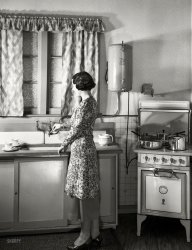
- A Close Shave: 1958
- New Zealand circa 1958. "Men's underwear being modeled, photographed by K.E. Niven ... most Americans would assume to be rather staid and proper, New Zealand seems -- at least as revealed thus far on Shorpy -- to be ... Posted by Dave - 06/09/2018 - 4:13pm -
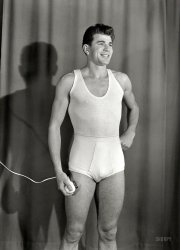
- The Natty Campers: 1905
- New Zealand circa 1905. "Male youths outside tent, probably Christchurch district." ... have been made homeless in the Aug. 9, 1904 earthquake in New Zealand, rated between 6.8 and 7.2 on the Richter scale. The tent may be ... Posted by Dave - 08/23/2013 - 7:34pm -
![The Natty Campers: 1905 New Zealand circa 1905. "Male youths outside tent, probably Christchurch district." Glass plate by Adam Maclay. View full size.
RE: Close to HomeAlso notice the regular beds. They certainly don't appear to be "roughing it" too badly.
Close to HomeLooks like they're camped out in their backyard. I notice the fence so they're not in the woods somewhere.
Serious Tie action going on; extreme knots, quite dapper.
Maybe it's like the Haitian tent citiesMy first thought as two why two young men would have semi-permanent furniture in a tent and dress in suits is that they may well not be "camping" but might have been made homeless in the Aug. 9, 1904 earthquake in New Zealand, rated between 6.8 and 7.2 on the Richter scale. The tent may be set up where a home used to be.
[No, this is a standard camping setup. Thousands of similar photos in the archive. - Dave]
They win!That is officially the DORKIEST pair of so-called camping outfits I have ever seen -- what a hoot!
Fancy campingIt appears that camping was either a serious business or a semi-permanent state in New Zealand. Other examples of Maclay's work show similarly impressive tent accommodations.
Question About Their TiesThose are some wide knots in their ties. It also looks as though the young fellow on the left has either a short tie or his tie has been cut off. But my question is about the fellow on the right's tie: Is that wide band going across his tie connected to his shirt to hold his tie in place? I've never seen that before. The cap worn by the fellow on the left is similar to what we used to wear in the Cub Scouts.
Catty NappersThe next post, the context here, and my general warpedness handed my mind that title, the first time I read it.
Accident Waiting to HappenTie your shoe, son, before you fall on that axe and hurt yourself.
(The Gallery, Adam Maclay, New Zealand)](https://www.shorpy.com/files/images/SHORPY_FL10635179.thumbnail.jpg)
- Battleship: 1940
- ... on the high seas. "Boxing match in progress on the deck of New Zealand troopship Dominion Monarch , carrying 2nd Echelon 4th Reinforcements ... Posted by Dave - 11/16/2013 - 11:06pm -
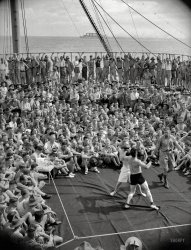
- Diplomatic Plates: 1942
- May 1942. Washington, D.C. "Garden party at the New Zealand legation. Chauffeurs and limousines." At right, a V-16 Cadillac. ... Posted by Dave - 05/13/2023 - 8:33pm -
![Diplomatic Plates: 1942 May 1942. Washington, D.C. "Garden party at the New Zealand legation. Chauffeurs and limousines." At right, a V-16 Cadillac. Acetate negative by Marjory Collins. View full size.
Buick LimitedAnd at left a 1941 Buick Series 90 Limited. I wonder what the meaning was of the "EIGHT" at the front?
[All Buicks of the era have "Buick Eight" on the front, because they're powered by an eight-cylinder engine. - Dave]
Looks like a Buick manJaunty cap angle, non-conformist socks, sitting on the bumper next to the senior man. That's where you pick up the extra things you might need to know.
Here's what the Census saysThe 1940 Census for Washington, D.C. shows a total of 1,892 chauffeurs. Of that, 54.8 percent were negro males and 43.6 percent were white males. Twenty-four chauffeurs were females. The subtotals don't exactly reconcile to the total, but they are not off by much.
Click to embiggen
Across the CircleNew Zealand Prime Minister Peter Fraser, who took office in 1940, believed they should not depend on Britain to entirely control its foreign policy and international trade. Adoption of the Lend Lease Act required frequent dealings with the U.S. government. So in 1941 he announced a plan to establish a legation in Washington. The building chosen, still standing today, is a Federalist-style mansion at 47 Observatory Circle NW - across from the Naval Observatory (now the official residence of the sitting vice president). Then, as now, there was a security fence and one row of parking spaces across the road, although today's fence is more attractive.
SpotlessOn the left a spotless 1941 Buick Super 8 Series 50. To the far left is what appears to be a 1941 Lincoln.
[That spotless car is a Series 90 Buick Limited. - Dave]
Sweet Sixteen1938 Cadillac Series 38-90 Seven-Passenger Imperial Limousine, coachwork by Fleetwood.
431 cubic-inch L-head V-16 engine
Dual downdraft carburetor
185 bhp at 3,800 rpm
*One of 95 built in 1938
(The Gallery, Cars, Trucks, Buses, D.C., Marjory Collins)](https://www.shorpy.com/files/images/SHORPY-8d04886a.thumbnail.jpg)
- Vivian Slippers: 1957
- Wellington, New Zealand, circa 1957. "Bond Street, formerly known as Old Customhouse Street, ... Burt. Shows a narrow city lane." National Library of New Zealand. View full size.
Those were the days When people knew ... Posted by Dave - 06/12/2017 - 9:08am -
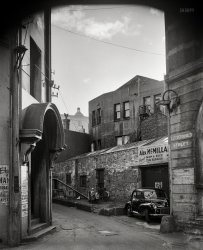
- Tyres & Fittings: 1910
- 1910. "Cycle shop interior. Christchurch, New Zealand." B.S.A. stood for Birmingham Small Arms. Photo by Steffano Francis ... Posted by Dave - 08/13/2013 - 3:30pm -
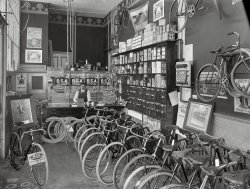
- Be a Tree: 1910
- New Zealand circa 1910. "Studio portrait, young woman in Christmas tree fancy dress ... "Balls" wearing that outfit. Don't they have real trees in New Zealand?
Could be Lady Gaga in another life. Heaven help us all.
... Posted by Dave - 11/30/2013 - 5:43pm -
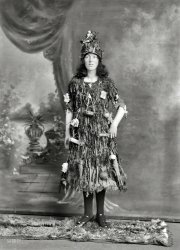
- WWWWW: 1962
- Wellington, New Zealand. "Worser Bay Surf Life Saving Club, team of 1962, with Cook Strait ... its narrowest point between the North and South Island of New Zealand.
It is an nasty piece of water where the Tasman Sea and the South ... Posted by Dave - 06/09/2018 - 4:16pm -
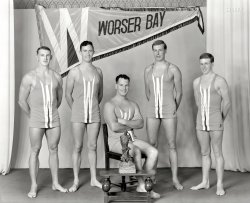
- Banded Brothers: 1905
- New Zealand circa 1905. "Men doing chores at a campsite, all in striped tops, ... flag at the far right is The flag of the United Tribes of New Zealand, the country's first official flag. It was flown between 1834 and ... Posted by Dave - 06/17/2014 - 7:03pm -
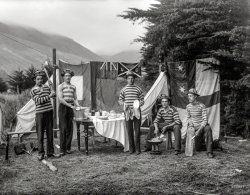
- Try Our Golden Crumpets
- 1950s. Wellington, New Zealand. "Interior of Sunshine Milk Bar lined with booths, photographed by K.E. ... Shillings (s) and Pence (d) on the cash register, that is. New Zealand went to dollars and cents in 1967.
Not Exactly Like the Korova ... Posted by Dave - 03/02/2014 - 8:37pm -
![Try Our Golden Crumpets 1950s. Wellington, New Zealand. "Interior of Sunshine Milk Bar lined with booths, photographed by K.E. Niven & Co." Large-format acetate negative, K.E. Niven & Co. Collection, Alexander Turnbull Library. View full size.
What a brand name!Scorched Almonds.
But that is a different and nifty ceiling, I must say.
You would thinkthat milk bars, with their abundance of candy and soda, would be geared toward a younger clientele. But there are ashtrays at every table.
When LSD was legalPounds (£), Shillings (s) and Pence (d) on the cash register, that is. New Zealand went to dollars and cents in 1967.
Not Exactly Like the KorovaThe dispensers on the counter are far more G Rated than the ones Alex and his droogs visited in Clockwork Orange. But there is that box of French Maids on the shelf to make you wonder just how G Rated this place was.
Nasty ashtraysI remember booths in cafes with those built in ashtrays, and having to breathe smoke while eating. I always took away a doggie bag, so I could eat the food without the side of burnt tobacco. Even though it was cold, it tasted better. Of course, I also had to time it for when my parents weren't smoking! I'm SO glad those days are over!
HideawayI guess the Alcove is where the young people went to make out.
Go Suck a --ZUBE. There is a dispenser for these on the shelf to the right. I remember a similar product in Australia in the 1960s called Hudson's Eumenthol Jujubes. They even boasted they could clear "smoker's catarrh."
I see you back thereNot often we get a chance to see the photographer and their camera. Dave, a closeup please from your high-res original?
Milk and cigarettesEach table has an ashtray. I can't imagine a combination more foul.
The till registers in pounds, shillings and pence. I wonder if those machines could be adapted to the new digital dollar or if they had to be scrapped.
Lunchroom SelfieLooks like the photographer and his view camera can be seen in the mirror at the end of the counter just under the light fixture that is hanging down.
Did no one notice him?I'm surprised that no one called out the photographer - he and his camera are reflected in the mirror at the end, just above the SEL(F) SERVE sign!
An All-Pervasive PallInteresting to read the (somewhat astonished?) comments on the ubiquitous ashtrays. I grew up in the late '50s, early '60s in the US, and everybody smoked. In the house, in the car, at work, on picnics -- everywhere I can think of, except church. I never thought a thing about it. It was no different than the weather: an all-pervasive fact of life, so what. But then my dad died from cancer of the larynx.
Not what you thinkDave, please embiggen the French Maid boxes, I think they say Salted Nuts and Confections. Clearly not what "aenthal" above thinks they are.
[Andrea was making a joke. - Dave]
This is so awesome.Flashback 60+ years ago. Note the trim-work molding. Do they make anything like this today?
FormicaRe: This is so awesome.
If you're referring to the top surface of the tables and the trim around their edges, this is a product called Formica. Formica sheet was widely used in New Zealand in the 1950's and 1960's for table tops and bench tops. Invented in the USA in 1912 and pronounced for-MY-cah.
(The Gallery, Eateries & Bars, New Zealand)](https://www.shorpy.com/files/images/SHORPY_FL17023039.thumbnail.jpg)
- You've Got Quail!
- New Zealand ca. 1920s. "Hunter with quail photographed by Frederick N. Jones of ... shoes back from the 1920s. Must have been a backwoods New Zealand thing I suppose?
Quail and potatoes? I certainly hope he was ... Posted by Dave - 05/19/2014 - 2:15pm -
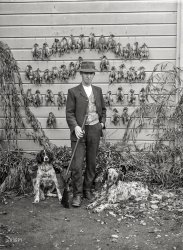
- Kiwi-Haw: 1905
- New Zealand circa 1905. "Eight young men in ragtag clothing with hats, pots, broom, ... and some of the others aren't bad, either. I love these New Zealand photos. Are there any that show the Maori?
Belt buckles ... Posted by Dave - 09/25/2013 - 9:49pm -
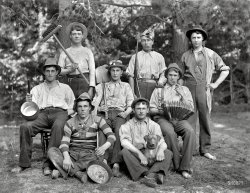
- Down Under: 1910
- ... over their one-piece suits.
-- Encyclopedia of New Zealand
New Zealand circa 1910. "Unidentified bathers, probably at ... Posted by Dave - 08/23/2013 - 7:45pm -
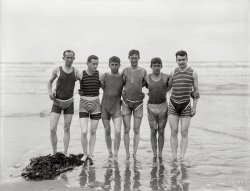
- What a Waist: 1920s
- ... or boxers?" Photo by the Gordon Burt Studio of Wellington, New Zealand. View full size.
What every man needed Suspenders to keep ... Posted by Dave - 10/10/2013 - 9:58pm -
![What a Waist: 1920s 1920s. "Men's underwear." Pondering the age-old question, "Boxers or boxers?" Photo by the Gordon Burt Studio of Wellington, New Zealand. View full size.
What every man neededSuspenders to keep his socks up in the days before elasticated tops.
[Those are called garters. -tterrace]
In the US maybe, in the UK and probably New Zealand they are called suspenders. Divided by a common language:-)
GartersWest Point used to issue those but the year before I entered science discovered elastic and garters became obsolete. My class was issued them nonetheless, and they remained an item of command interest during wall locker inspections throughout my four years.
No See?I wonder if the "extra layer of protection" is an Extra Tall undershirt with long hem or tail? Some American football players are sporting this look right now, possibly because their pants are "see thru" when soaked by sweat.
Hair colorist neededWho does his hair?
Double protectionIt looks like he already has two pair on! My Mom always told me to make sure that I wore clean underwear in case I was in an accident, but this is a bit ridiculous.
[The world was not ready for the see-through look quite yet. -tterrace]
Cheap rug or a fright wigIn my opinion, that is what he is wearing because the top front hair bears no resemblance to the rest of the hair. Although this look is popular now, I'm pretty sure it was not around in the 1920's.
[This was known as the "military" hairstyle, popular in the late-teens and into the 1920s. For example, these guys from a 1917 Maryland college yearbook. -tterrace]
(The Gallery, New Zealand)](https://www.shorpy.com/files/images/SHORPY_FL16828191.thumbnail.jpg)
- Walk Like a Polynesian: 1920
- Lasses in grasses circa 1920s. "Nelson District, New Zealand. Row of young women (music hall dancers?) in costume, standing barefoot ... Posted by Dave - 07/03/2014 - 10:43am -
![Walk Like a Polynesian: 1920 Lasses in grasses circa 1920s. "Nelson District, New Zealand. Row of young women (music hall dancers?) in costume, standing barefoot in dance pose, wearing headbands, long strings of beads, Hawaiian hula style grass skirts and anklets." Glass negative by Frederick Nelson Jones. View full size.
Pantomime?I'd say these are all schoolgirls and it's part of an end of year celebration or pantomime (British usage: "A kind of play performed at Christmas time characterized by farce, music, lavish sets, stock roles, and topical jokes." - Collins Dictionary 1987.)
Ankle watchThe third girl from the left appears to be wearing a wristwatch on her ankle and she also looks like she might be a sister to the girl on the extreme right. I've heard "men don't make passes at girls who wear glasses" but what about girls who wear grasses?
The Belle SistersMiserabelle, Horribelle, Terribelle, and their cousins.
Burritos at bedtimeIf I had hoped for pleasant dreams of smiling Polynesian girls in grass skirts, I don't think this was what I had in mind. Gotta watch the late-night snacks.
It Must Be The EyesNope, nope, nope, nope, nope, yep, nope, nope, nope, nope.
Perhaps down under-One's wristwatch needn't be worn in the customary place?
Fraternity Hi-Jinks?Not entirely convinced that these are women...
Some Like it Hot.I think I see Jack Lemmon and Tony Curtis.
Fifth from leftThat well-known Kiwi thespian, Beryl Streep.
[She's a gem, all right. -tterrace]
Very Young Pythons???Might this be a long forgotten Monty Python sketch???? Fourth from the right looks like a very young Eric Idle while third from the left looks like a very young Michael Palin....
"Hawaiian" hula style grass skirts? More likely that the ladies are emulating native New Zealand Maori dress.
(The Gallery, Dance, New Zealand)](https://www.shorpy.com/files/images/SHORPY-FL16692146.thumbnail.jpg)
- Family Butcher: 1910
- 1910. Wellington, New Zealand. "David Taylor's butcher shop, Wadestown, showing decorated carcasses ... Pitt Thanks for sharing these fascinating views of New Zealand. The location is the Wadestown Road/Pitt Street intersection, for ... Posted by Dave - 06/09/2018 - 5:33pm -
![Family Butcher: 1910 1910. Wellington, New Zealand. "David Taylor's butcher shop, Wadestown, showing decorated carcasses and horse-drawn delivery cart. David Taylor in doorway." Glass plate negative by Frederick James Halse. View full size.
Everything is strangeIt is all quite odd. The bizarre "decorations" of the carcasses, the strange aprons, the "family butcher" logo, and of course the meat exposed to whatever flies and other vermin might happen by. I would love to know more.
Scared/Trained DogsHard to imagine a couple of dogs that close to raw meat without showing too much interest. The dog in the street might be interested (hard to tell with its pose) but the one on the sidewalk seems oblivious.
[That's because they don't want to be the next doggie in the window. -Dave]
TaperedThe left side of the shop appears to be missing, since the distant hills and other structures behind are quite visible where they should be blocked by the depth of the building.
I am thinking that the building's footprint is really a parallelogram vs a rectangle. If that is the case then the building's side walls are going straight away from the camera axis and the side wouldn't be visible. If the footprint was a rectangle then the side walls would be perpendicular to the street and the side would be visible.
[My money would be on trapezoidal or triangular. Or maybe the whole business is just a front. -Dave]
Family Butcher!I think I see Aunt Martha hanging in the window.
Family ButchersThe phrase is still quite common in the UK (and still provides amusement).
Here's one near me.
Wadestown & PittThanks for sharing these fascinating views of New Zealand. The location is the Wadestown Road/Pitt Street intersection, for people who want to have a look. There is a shop today on the spot occupied here by Mr Taylor's establishment, and it is indeed trapezoidal.
[Street view. -tterrace]
View Larger Map
Blazing SaddlesLooks like a Mel Brooks movie set.
Ed GeinWould be jealous!
(The Gallery, Bizarre, Dogs, Horses, New Zealand, Stores & Markets)](https://www.shorpy.com/files/images/SHORPY_FL16800669.thumbnail.jpg)
- Can We Go Home Now?
- Circa 1890s New Zealand. "Carte de visite portrait, Maori woman and child from Hawkes Bay." ... the pile were attached to a foundation of finger-woven New Zealand flax fiber.
Update on Moko The derelict movie theatre was ... Posted by Dave - 10/30/2013 - 10:54pm -
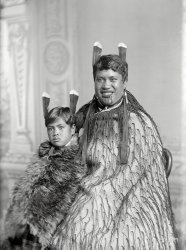
- Lily Living: 1910
- New Zealand circa 1910. "Young men in formal wear at table ready to have a meal, ... full size.
Stars and Stripes The caption reads "New Zealand" but that is definitely an American flag flying above the tent.
... Posted by Dave - 01/14/2014 - 4:04pm -
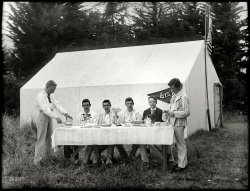
- Farmers Co-op: 1917
- Circa 1917. "Motor cars in New Zealand Farmers Co-Op Garage." Glass plate by Samuel Heath Head, Christchurch. ... Hupmobile exported a fair number of cars to New Zealand; I believe there may be as many as four Hupmobiles in this photo. ... Posted by Dave - 08/27/2013 - 9:50pm -
![Farmers Co-op: 1917 Circa 1917. "Motor cars in New Zealand Farmers Co-Op Garage." Glass plate by Samuel Heath Head, Christchurch. View full size.
Do you recognize?Any De Dion Boutons, Silent Sunbeams, 10-horsepower Austins, Siddeley-Deasys, Noiseless Napiers, American Mitchells, Maxwells or Buicks?
That "coffin nosed" caris most like a Renault.The only other car with a cowl like that was a Franklin but I don't believe a Franklin would have had delicately spoked wire wheels like this car wears.
The second car from the rightI'm really curious to know what make that coffin-nosed auto is.
Calling all car nuts!
RoundhouseIt seems the parking in tight quarters is aided by the two (at least) large discs embedded into the floor.
[Turntables. - Dave]
"Coffin Nose"The car in question appears on Manalto's list- it would have to be a Siddley-Deasey. Two cars beyond that is a nice Hupmobile.
OverallA very high-end looking group. Apparently, there was good money in sheep circa 1917.
Before ABSThe vehicle in the near center foreground sports a 'NonSkid' brand tire on the left front. On the left rear is a 'MaySkid' tire.
Hupps-a-plentyHupmobile exported a fair number of cars to New Zealand; I believe there may be as many as four Hupmobiles in this photo. The one previously identified by Roverdriver (two down from the Siddeley-Deasy) is a 1912-1915 Hupmobile Model 32. The neighboring car beyond that is also a Hupp: a 1916 Model N. In the front left foreground, the two small runabouts with matching fenders are 1910-1912 Hupp Model 20's, the first model produced by Hupmobile. On the left runabout, it looks like the missing tire from the front right wheel is resting in the back seat of the car.
DefinitelySiddeley-Deasy. A 18-24hp from 1913 is shown below.
(The Gallery, Cars, Trucks, Buses, New Zealand)](https://www.shorpy.com/files/images/SHORPY_FL16977685.thumbnail.jpg)























